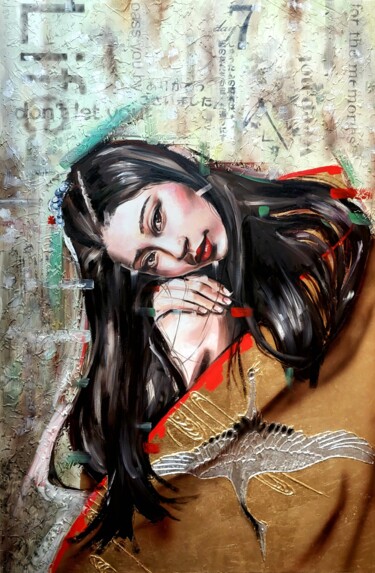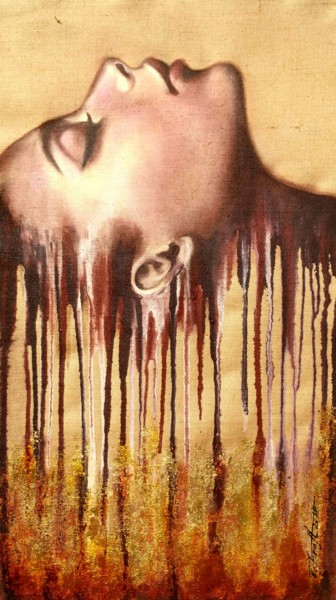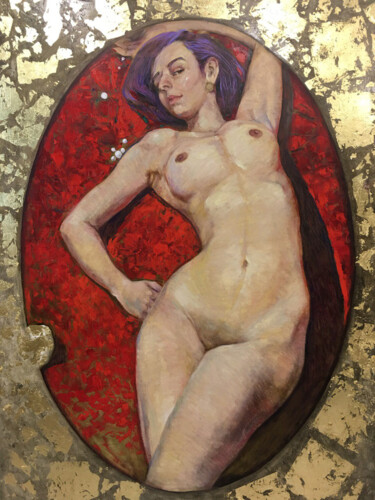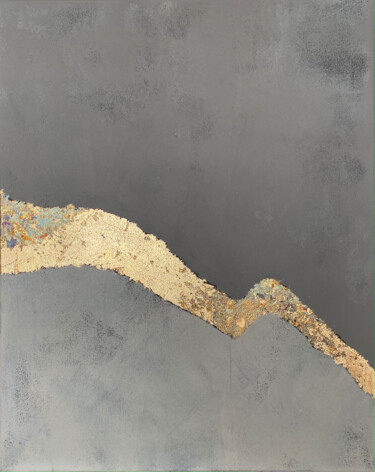FOR A LONG TIME (2021)Painting by Rupert Cefai.
In the title
When we think of gold within the history of art, it turns out to be rather easy, if not taken for granted, to focus and dwell on one artistic technique in particular, which, just for the moment, I want to set aside, seeking to enhance another, rather unprecedented, narrative, aimed at explicating the object of our investigation, referring exclusively to some titles of pictorial masterpieces, which, containing the word gold, have referred to the properties and intrinsic symbolic value of the aforementioned metal, without actually making use of it. Pursuing the assumption in question, I begin with the oil on panel painting of c. 1576-1581 made by Jacopo Zucchi and titled, precisely, The Age of Gold, a masterpiece in which the small format accommodates a wealth of characters and details drawn from the mythological theme, referring to the version narrated by Ovid's Metamorphoses, the treatment of which is made explicit by the inscription in Italian, which appears to be supported above by two naked women in flight. The scene, which in its upper part presents in its center a mountain from which various rivers flow, represented by river gods, while in the lower part of the support depicts harmony among humans, animals and plants, would use the word gold, the subject of our investigation, in a rather positive, prosperous and idyllic way, as it links this name to that of the Golden Age: a mythical time par excellence, in which human beings lived without the need for laws, nor did they have the need to cultivate the land, as every plant was capable of growing spontaneously. In fact, without using the metal in question, but only mentioning its beneficial properties in the title, the painting takes us to a distant and coveted era, exempt from hatred between individuals and wars, marked by an eternal spring, in which there is no need to build houses for shelter. If for Zucchi, gold is associated with and a wondrous period now decidedly exhausted, what does Miró think about it? This we can find out, or rather deduce, by looking at the work of the Spanish Surrealist artist titled, precisely, The Gold of the Azure (1967), a masterpiece where, in fact, the brightness is brought by the color yellow rather than gold, a chromaticism that serves as a background for unidentified black, blue and red shapes and lines, the purpose of which is to refuse to yield to any fixed interpretation. In this way, even the almost irrelevant reference to the metal in question is transformed into an authentic statement of the poetics of the painter, who is extremely well known for creating a vocabulary of constant signs, which, because they were not associated with a dictionary of convention to refer to, remain partly unknowable, despite the fact that the painter revealed how each of them actually referred back to a concrete form.
 UNTITLED191212 (2019)Painting by Tsunshan.
UNTITLED191212 (2019)Painting by Tsunshan.
 GOLDEN MEETINGS (2022)Painting by Alena Sobolevskaia.
GOLDEN MEETINGS (2022)Painting by Alena Sobolevskaia.
In the technique
Having illustrated how gold appeared in some titles of famous paintings, without, of course, having dealt exhaustively with the subject in question, let us go on to analyze some masterpieces, which, indeed, welcome within them gilded surfaces, executed by means of a specific technique, which will be briefly explained later. To do what has been explicated I will start geographically, as well as chronologically, from the Netherlands, continuing through Italy and ending in Austria, countries where the artifices of the works that will be first described and, later, analyzed in unison in their technique of execution originated. Speaking of the Netherlands I bring as an example Henri Bellechose's Trinity and Stories of St. Dionysius (1416), tempera and gold on panel that immortalizes two scenes from the last days of the saint in question, aimed at taking shape in the event of communion and beheading, headed in the center of the depiction of the Trinity, where God the Father holding the cross of his son witnesses the appearance of the Holy Spirit's coloba. Turning succinctly to the Polyptych of Mercy by Italy's Piero della Francesca, the oil, tempera, and gold ground on panel depicts, in its most compelling central part, a Virgin opening her cloak offering shelter and protection to the people who venerate her, literally of the faithful depicted in a hierarchically smaller manner. From the sacred gold, understood as a perfect backdrop to render the timelessness, the luminous and abstract, of the divine dimension, we move on to Klimt's secular context, made explicit, among other things, in the masterpiece dated 1902 and titled Beethoven Frieze, in which the painter sought to give form to the Ninth Symphony, composing a work whose three painted walls constitute a coherent sequence, which, from the clash between happiness and hostile forces, lead to the triumph of the Ode to Joy. Finally, the very Netherlands, Italy and Austria accompany us in the revelation of the gold painting technique in question: the gold background, aimed at materializing in the laying of a very thin sheet of gold (gold leaf) on the background of the paintings, a practice having its most famous origins in the mosaics spread since the early Christian era, which later became painting, and which was gradually put aside during the 14th century, a time when, thanks to Giotto's innovations, more realistic architectural and landscape backgrounds began to be preferred, which caused a progressive reduction in the percentage of the panel decorated in gold. At this point, the art historical narrative takes other paths, developing into the analysis of three paintings by some of Artmajeur's artists, including gilded parts...
 DREAM (2019)Painting by Viktor Horiaiev.
DREAM (2019)Painting by Viktor Horiaiev.
Viktor Horiaiev: Dream
It is Sunday morning and, after an eventful and alcoholic Saturday night, we awaken in a kind of mystical vision, in which our golden bed envelops us in its own light, to reveal to us, perhaps, what we have been up to the previous night, amidst obvious memory lapses and, perhaps, some unforgivable repentance. Despite these controversial thoughts, the protagonist of the work in question seems quite calm, as if she has achieved the serenity that only a divine glow can confer, so much so that she is visibly engrossed in gazing at her golden sheets, if only to imagine how much money she could make if she sold them to the nearest gold buyer. Nonsense aside, do you know how gold matches the bed theme and thus the dream world? Gold, a valuable and durable metal that has always been associated with the concepts of immortality, eternity and royalty, as well as with the elite ethical qualities of purity, loyalty, courage, clemency, charity, justice and fortitude, is definitely a good omen if it appears to us in a dream, as it alludes to success, achievement of set goals and prosperity. In addition, the color of the sun and Apollo indicates the virtue of the dreamer, such as, for example, moral sense and love, presenting itself also as a good omen for the desirable assumption of leadership positions of the same, as well as the achievement of fame. In the negative sense, on the other hand, a golden dream could be linked to a sense of nostalgia for the long-gone years of youth, or to a kind of anxiety nurtured for those longed-for but still unfulfilled desires.
 LOVE ORIGINAL PAINTING. GOLDEN DECORATIVE ARTWORK GOLD LEAF (2023)Painting by Irina Bast.
LOVE ORIGINAL PAINTING. GOLDEN DECORATIVE ARTWORK GOLD LEAF (2023)Painting by Irina Bast.
Irina Bast: Love original painting
Needless to go round and round, Irina Bast's work has given rise to a new and unprecedented interpretation of Klimt's kiss, where, however, the fact made explicit by the title of the 1907-08 masterpiece does not occur, as the effigies in Love original painting merely bring their faces together in the act of giving birth to a tender embrace, evidently not inclusive of the resting of the lips on the surface of the beloved's skin. The source of inspiration for the use of the gold leaf technique, however, remains unknown in the case of the artist from Artmajeur, while, with regard to the Austrian master, it is known how he, in order to bring to life a masterpiece capable of representing a symbol of the Secession period, drew examples from the Byzantine mosaics of Ravenna, the study of which gave rise to the aforementioned painting, in which the subjects bring their bodies closer together within a luminous, abstract and, consequently, timeless background. In this context, where three-dimensional space is annulled, the effigies take on a two-dimensional appearance, while, together with the lawn and robes, they are structured through hyper-decorated fields, whose form is defined through contrasts of color and brightness. Regarding the meaning of the masterpiece, however, it captures the moment when the masculine and feminine universes interpenetrate, making concrete the triumph of the unifying power of eros, aimed at bringing together two primarily different worlds, brought together within a luminous gold container, aimed at making the power of love concrete and divine.
 LUMINOUS SILENCE (2017)Painting by Adriana Plucha.
LUMINOUS SILENCE (2017)Painting by Adriana Plucha.
Adriana Plucha: Luminous silence
Referring to the words of the artist in Artmajeur, the works that are part of the series The gardens of the world, inclusive, of both paintings and sculptures, grant the viewer, in the case of Luminous silence through the use of gold, the achievement of serenity. This state of mind coveted by many is achieved through an art, which encourages the exercise of silent conteplation, capable of inducing fruitful inner meditation, fostered by that peculiar combination of minimalism, color and delicacy, ready to emphasize the spontaneity of nature and landscapes investigated. Certainly, the main sources of inspiration for the realization of this type of subjects were drawn from Asian culture, particularly Japanese prints and painting, known for their monochromatic colors and strong attention to detail. These influences take new form through the use of a very personal natural tempera technique, which, based on an egg-based binder, sees the skillful use of flaked gold, as well as the occasional use of silver leaf and platinum. Finally, if we were to juxtapose Luminous silence with the more Western narrative of art history, the gold background would surely bring to mind timeless spiritual iconography, while the floral subject matter, in itself, might harken back to the perspective cut according to which, roughly 127 years earlier, Van Gogh portrayed his Flowering Almond Tree Branch (1890).

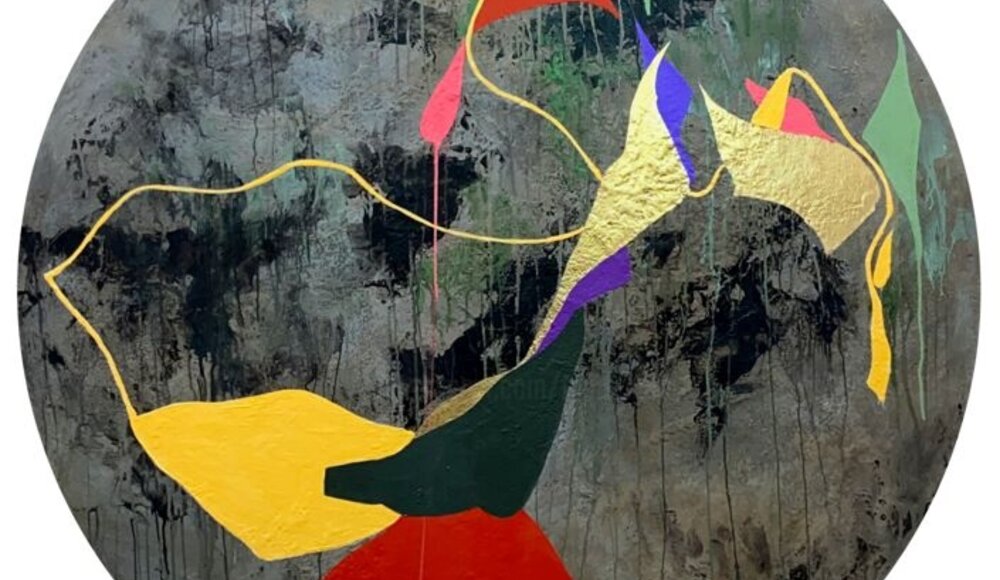

 Olimpia Gaia Martinelli
Olimpia Gaia Martinelli

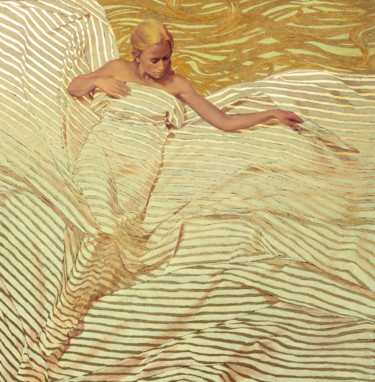
![Painting titled "Propoetide [II]" by Stephan Joachim, Original Artwork, Acrylic](https://www.artmajeur.com/medias/mini/s/t/stephan-joachim/artwork/16060981_propoetide-ii.jpg)


